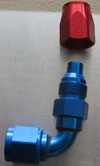Which Surface Treatment Is Best?
 Race engine crankshafts are typically produced from steel billets and are gas nitrided to improve fatigue life and reduce wear.
Race engine crankshafts are typically produced from steel billets and are gas nitrided to improve fatigue life and reduce wear.
However nitriding is not suitable for all crankshafts, as the author found recently whilst detailing a crankshaft from a 70-year old historic Grand Prix racing engine. The crankshaft in question ran with rolling element main and crankpin bearings, in which the actual rollers ran directly on the journal surfaces of the crankshaft.
Under these circumstances nitriding should not (generally) be specified. Nitriding forms a very hard but relatively thin layer on the journal surface, which can almost be likened to an egg shell. The Hertzian contact stresses from the individual rollers can overload this hard outer skin and cause it to crack and break up. This will lead to breakdown of the whole surface, which coupled with the hard pieces of debris from the nitrided layer will lead to accelerated wear of the journal and eventual bearing failure.
The two surface treatments which are typically recommended for this situation are induction hardening and case hardening. But which one was finally specified for this application? Induction hardening is a non contact process in which a conductive work piece is placed into a strong alternating magnetic field. This magnetic field induces an electric current in the work piece which heats it due to the I2R losses.
The generated current is concentrated in the outer surface layer; the depth of this layer being determined by the frequency of the alternating field, the surface power density, the permeability of the material, the heat time and the diameter of the bar.
The work piece is then quenched in a conventional manner to modify the microstructure of the outer surface to achieve the desired properties.
For induction hardening to operate successfully the carbon content of the steel should be 0.40%; hence 708M40 / EN19 is a favoured material for an induction hardened crankshaft. There are many advantages to induction hardening. When a crank is nitrided the whole crankshaft is heated which leads to distortion, which must be dealt with either by leaving material stock on or by a straightening operation post nitriding. With induction hardening, only the surfaces which actually need to be hardened are heated, and they can be heated in any order (i.e. you don’t have to start at the front and do the journals in order). This means that it is possible to greatly reduced distortion.
The second advantage is speed. A typical gas nitriding process will involve the crankshaft being in the furnace at temperature for 90 hours, after which the straightening operation must then be performed.
To induction harden a journal takes just several minutes depending on various parameters, making it vastly quicker. This could remove a week from the crankshaft lead time.
So why are all cranks not induction hardened? Well, large production runs of tens of thousands of crankshafts often are.
The primary reason why race engine cranks aren’t, is the high cost of the tooling which makes it uneconomical for small batches. Special inductors are produced which will only suit one journal diameter, they are complex and relatively expensive and can cost thousands of pounds.
The secondary reason would be availability. As induction hardening is relatively uncommon it requires more research and setting up to get it done. Most crankshaft manufacturers do not have in-house induction hardening capability and are only asked to do it infrequently.
Next month we will look at case hardening and we will reveal which option was chosen for the historic crankshaft.
Written by Tom Sharp.